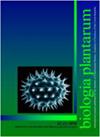苍术萜类合成酶基因AlTPS1的克隆及功能分析
IF 0.9
4区 生物学
Q4 PLANT SCIENCES
引用次数: 0
摘要
萜类化合物是植物次生代谢产物中最大的一类,其结构非常多样,已鉴定出超过50000种天然产物(Vattekkatte等人,2018)。它们在各种基本的植物过程中具有重要功能(如信号分子和植物激素),在植物次生代谢中发挥着无数作用,如排斥草食动物、吸引有益生物、植物之间的交流以及调解与环境的复杂相互作用(Pichersky和Raguso,2018)。萜类化合物在化妆品、调味品、制药、化学工业和生物燃料替代品中的广泛应用使萜类化合物变得不可或缺(Pyne等人,2019)。尽管萜类化合物具有不同的化学结构,但它们是由两种可相互转化的五碳化合物生物合成的:异戊烯基二磷酸(IPP)及其烯丙基异构体二甲基烯丙基二磷酸(DMAPP)。这些化合物分别通过质体和细胞质中的甲基赤藓糖醇磷酸(MEP)和甲羟戊酸(MVA)途径产生(Vattekkatte等人,2018)。IPP和DMAPP然后通过异戊二烯转移酶从头到尾缩合,产生萜烯前体本文章由计算机程序翻译,如有差异,请以英文原文为准。
Cloning and functional characterization of a terpene synthase gene AlTPS1 from Atractylodes lancea
Terpenoids form the largest class of plant secondary metabolites are very structurally diverse, with more than 50 000 natural products identified (Vattekkatte et al. 2018). They have essential functions in various basic plant processes (e.g., signaling molecules and phytohormones) and myriad roles in plant secondary metabolism, such as the repelling of herbivores, attraction of beneficial organisms, communication between plants, and mediation of complex interactions with the environment (Pichersky and Raguso 2018). Their extensive use in cosmetics, as flavorings, in pharmaceuticals, in the chemical industry, and as biofuel substitutes has made terpenoids indispensable (Pyne et al. 2019). Although terpenoids have different chemical structures, they are biosynthesized from two interconvertible fivecarbon compounds: isopentenyl diphosphate (IPP) and its allylic isomer dimethylallyl diphosphate (DMAPP). These compounds are generated separately by the methylerythritol phosphate (MEP) and mevalonic acid (MVA) pathways in plastids and the cytoplasm, respectively (Vattekkatte et al. 2018). IPP and DMAPP are then condensed head-to-tail by prenyltransferases to produce the terpene precursors
求助全文
通过发布文献求助,成功后即可免费获取论文全文。
去求助
来源期刊

Biologia Plantarum
生物-植物科学
CiteScore
2.80
自引率
0.00%
发文量
28
审稿时长
3.3 months
期刊介绍:
BIOLOGIA PLANTARUM is an international journal for experimental botany. It publishes original scientific papers and brief communications, reviews on specialized topics, and book reviews in plant physiology, plant biochemistry and biophysics, physiological anatomy, ecophysiology, genetics, molecular biology, cell biology, evolution, and pathophysiology. All papers should contribute substantially to the current level of plant science and combine originality with a potential general interest. The journal focuses on model and crop plants, as well as on under-investigated species.
 求助内容:
求助内容: 应助结果提醒方式:
应助结果提醒方式:


